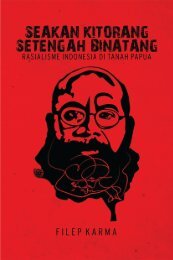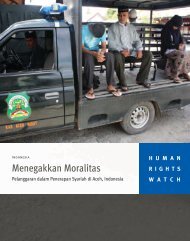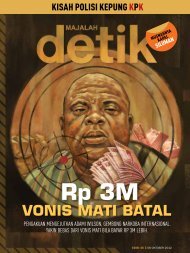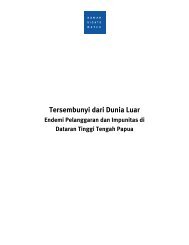Postcolonial Citizenship
PDF-6104Weboratie_Van_Klinken_-_DEF
PDF-6104Weboratie_Van_Klinken_-_DEF
You also want an ePaper? Increase the reach of your titles
YUMPU automatically turns print PDFs into web optimized ePapers that Google loves.
no trouble seeing that protest as a flare-up of a fight that had lain dormant<br />
since the 1920s. He had sentenced Jan Djong and the others to six months<br />
prison.<br />
Nor did the 1953 ‘demonstration’ mean that Djong had abandoned violence<br />
and become a follower of Daniel O’Connell. Several years of lawlessness ensued<br />
in which roving bands of villagers burned and robbed. This came to be<br />
known as the ‘scorched earth’ period (bumi hangus). Jan Djong must have<br />
been involved in at least some of it, because in 1957 he was sentenced again,<br />
this time by a modern court. He got three years prison for encouraging violence.<br />
There were other informal institutions as well. We only have time to sketch<br />
the barest details of three of them. Just enough to ask the question: How do<br />
the informal and the formal institutions of citizenship relate to each other?<br />
Does one weaken and undermine the other, or could they also work together<br />
for good?<br />
The ethnic organization<br />
Another informal institution was the ethnic organization. This too was a mix<br />
of old and new. In between demonstrating – June 1953 was not the last – and<br />
half encouraging a bit of burning and bashing, Jan Djong became a politician.<br />
The Raja of Sikka died suddenly of a heart attack in May 1954, and republican<br />
institutions soon began to fill the void. That included an elected local assembly,<br />
and professional bureaucrats with legally limited mandates. Political parties<br />
were poorly developed in the 1950s. Djong’s main organizational instrument<br />
was an ethnic organization named Kanilima. This name was an<br />
acronym from the three former kingdoms in the hills around Maumere that<br />
had lost their autonomy to the Raja of Sikka in the 1920s – Kanga’e, Nita, and<br />
Lio-Maumere. Kanilima was a rural coalition against the elite in Maumere<br />
township. The ‘ethnic’ representatives that belonged to it did not claim aristocratic<br />
descent – they were emerging middle class officials and politicians like<br />
Jan Djong. Their complaint, too, was modern. They started it because they felt<br />
Raja Thomas was depriving them of state scholarships and bureaucratic jobs.<br />
Their protest met with success. The principle of ethnic representation was<br />
soon formalized. Jan Djong became an assembly member on behalf of the<br />
Kanga’e kingdom, now renamed the Kanga’e ‘ethnic group.’ The group also<br />
won control over the copra-funded junior high school over which it had demonstrated<br />
in 1953. The novel idea that public matters such as finance and<br />
education should be run by elected assemblies had been widely accepted as<br />
MURDER IN MAUMERE: POSTCOLONIAL CITIZENSHIP 11






